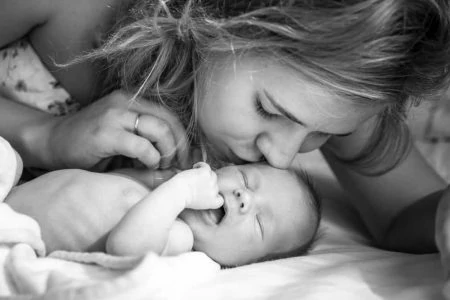Planned home births are becoming a more common choice for families. Statistically, home births lead to fewer medical interventions such as c-sections, and they also allow the birthing person to be in a calming and familiar environment.
But home births are not the right choice for everyone. While there are many benefits, there are also some significant risks and complications to consider.
Our guide, backed by extensive research from official studies and medical journals, presents 25 compelling home-birthing statistics and facts to help you make an informed decision.
5 Key Facts About Home Births
Below are five key home birth statistics and facts, but we have plenty more in-depth facts throughout the article if you’re keen to know more.
- Between 2019 and 2022, there was a 22 percent increase in home births.
- Hospital births have a lower infant mortality rate than intended home births.
- Mothers who have a home birth are more likely to exclusively breastfeed their babies.
- Mothers who have a home birth are less likely to experience tears and lacerations.
- Mothers who have a home birth have a higher chance of uterine rupture during labor and delivery.
25 Statistics and Facts About Home Birthing
Embark on a journey through 25 interesting statistics and facts about home birthing, offering a detailed insight into the pros and cons of this increasingly popular choice.
Home Birth Vs. Hospital Birth Statistics
Compare and contrast the critical statistics and percentages of home births versus hospital births to understand the differences and make an informed choice.
- During the pandemic, home birth rates increased: Due to concerns about the pandemic, there was the biggest increase in families choosing a home birth since 1990 (1). Between 2019 and 2022, there was a 22 percent increase in home births, totaling 1.26 percent of births in the U.S.
- One study found US hospital births to be safer for the baby: One study in the U.S. found that the risk of neonatal death was higher for intended home delivery (2). Planned hospital births resulted in 1.8 deaths per 1,000 and 3.9 for intended home delivery.
- Out-of-hospital births resulted in lower APGAR scores: Planned home births resulted in babies with a lower APGAR score (five checks to measure a baby’s health). Planned home births also increased the baby’s chance of having a seizure or needing a ventilator, as well as the mother requiring a blood transfusion.
- Home birth decreases the chance of interventions: The same study found that intended home births also resulted in fewer interventions, including induction, forceps, vacuum delivery, c-section, and tearing. It also lowered the baby’s chance of spending time in the intensive care unit.
- Percentage of women who are transferred to hospital: Of those intending to have a home birth, around 15 percent are transferred to hospital. The number is about nine percent for mothers who have given birth before (3).
- Home birth vs hospital births in Canada: A Canadian study found hospital births to be less safe for the baby. Of 1000 births, there was a 0.35 death rate amongst planned home births compared to 0.57 amongst planned hospital births (4).
- Hospital births are best for pregnancies that have risk factors: A home birth is not the safest option for risky pregnancies. For instance, if the mother has gestational diabetes, if she is expecting multiples, or if the baby is breech, a hospital birth is safest.
- Home birth is less expensive: The cost of a home birth versus a hospital birth is drastically different. One study found that the average home birth cost in the U.S. was about $4650 (5). However, some insurance policies do not cover home births. The average hospital birth cost is $18,865, but health insurance can cover most of this (6). Note that the cost of birthing varies by country and state.
Benefits of Home Births
Home birth can seem like a daunting decision, especially since it’s not very common in the U.S. Whether you’re considering a home birth or simply want to know more, below are nine benefits of a home birth if you have a low-risk pregnancy.
- The mothers control the environment: When mothers give birth at home, they control the environment and experience. They can decide how they want the lighting, the music, which room they give birth in, and who is there. This creates a familiar and comfortable setting which can relax the mother, making birth easier. After all, birth is a painful experience, and even the smallest of home comforts can make mothers more settled.
- The baby is more likely to be breastfed: A Canadian study found that women who had a planned home birth were more likely to be exclusively breastfeeding at six weeks postpartum (7). Eighty-seven-point-five percent of infants were exclusively breastfed from the planned home birth group versus 76.8 percent from the hospital birth group.
- Mothers have fewer interventions: Mothers who have a planned home birth have fewer interventions, including induction or operative vaginal delivery, compared to women who give birth at a hospital. A Canadian study found that women who intended a home birth had a 5.2 percent c-section rate compared to 8.1 percent of low-risk women who planned a hospital birth.
- Home births cost less: As mentioned before, home births are, on average, 75 percent cheaper than hospital births. However, the cost can be comparable or even higher if covered by insurance.
- Home birth allows for immediate bonding: When a mother gives birth at home, they have a better opportunity for immediate bonding with the baby. They can crawl back into their own bed with their familiar comforts and focus on the baby. Many people feel out of place or uncomfortable at hospitals, leading to delayed bonding with the baby.
- Mothers are less likely to experience tears: Women who had a planned home birth were less likely to have vaginal and perineal tears, lacerations, and fatal infections (8).
- Low-risk second-time mothers have great home birth outcomes: Between four and nine percent of women who have given birth before require transfer to a hospital during labor (9). About 23 to 27 percent of first-time mothers require a transfer.
- They’re convenient for women who have quick births: If a woman has a very short labor, their next labor is likely also to be swift. Planning a home birth allows the woman to be in a safe place with support when the baby arrives. On the other hand, if the woman planned a hospital birth, she has an increased risk of delivering on the way to the hospital, which is less safe.
- More likely to have an unmedicated (natural) birth: While medication during birth should be a woman’s choice, research has found that there is not always a process of informed consent. Women who didn’t want medication during birth often felt pressured during the birth process. A home birth significantly reduces a woman’s chance of having pharmacological pain relief.
Risk and Complications of Home Birthing
There is no one-size-fits-all when it comes to childbirth. While home birthing has many notable advantages, understanding the risks and potential dangers is essential for making a safe and informed decision about your birthing plan.
- Home birthing is associated with higher rates of infant death: Planned hospital births result in 1.8 deaths per 1,000 babies, compared to 3.9 for intended home delivery. Overall, planned hospital births are statistically safer for the infant.
- Midwife licensing differs by state: In other countries, such as the U.K., home birthing is an optional part of the nation’s healthcare system. This means you get a midwife at your home birth who is just as qualified as midwives who work in hospitals. But in the U.S., there are many types of midwives, including certified nurse midwives (the best option), certified professional midwives (they haven’t graduated from a midwifery course and cannot administer medication), and lay midwives (10). Lay midwives are trained in childbirth, but they have no license or certification, and they cannot administer medication.
- If you have any complications, you’re at risk: If you experienced any complications during pregnancy, you are a riskier candidate for home birthing. Your pregnancy must be low-risk to be suitably safe for an intended home birth.
- Higher risk of neurological dysfunction for the infant: Studies found that home births or births in freestanding birth centers led to a higher risk of serious neurological dysfunction compared to hospital births (11).
- It can be hard to transfer women to a hospital: If a woman requires a hospital transfer, it can be difficult if there is a delay or a long distance. This can contribute to adverse neonatal outcomes.
- Infant death rates are higher for breech babies: Breech-presenting babies have a higher intrapartum mortality rate (13.5 per 1000) and neonatal mortality rate (9.2 per 1000) when the mother intends to have a home birth.
- Home birth is risky if the mother has had a previous c-section: The intrapartum mortality rate for the baby is 2.9 per 1,000 in mothers who plan a home birth after a c-section. This is compared to 0.13 per 1,000 for planned hospital births.
- Higher risk of uterine rupture: Even low-risk mothers who intend a home birth have a higher risk of uterine rupture during labor and delivery (12).
Overall, home birth should only be a consideration for mothers who have had previous non-complicated pregnancies, are under the care of a certified nurse-midwife, and have prompt access to a hospital.
Who Is Eligible for a Home Birth?
Ultimately, women are in control of their own birthing choices. However, most healthcare providers would be hesitant to support a home birth if there are pre-existing maternal diseases, pregnancy complications, and illnesses, or if the mother is expecting multiples.
Mothers expecting breech-presenting babies or babies arriving early (before 37 weeks) or late (after 42 weeks) should also seriously consider a hospital birth.
If the mother experiences any of the above, then the risk of perinatal death is higher.










